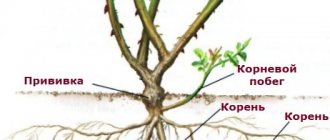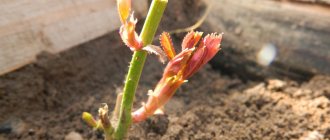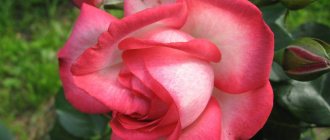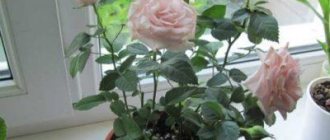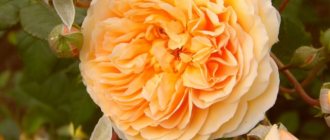Description of the variety Mimi Eden
The rose variety Mimi Eden has average resistance to fungal diseases; it gets sick during the spread of infection and with improper care. The flowering of the bush worsens in rainy weather.
The frost resistance of the variety is average, withstands temperatures down to -26 degrees. The period of active flowering of the crop lasts from mid-June to mid-September, during which time the plant produces 2-3 waves with breaks of 2 weeks.
| Color | Deep pink, white edges |
| Number of flowers per stem | From 5 to 10 |
| Aroma | Weak |
| Flower size | 3-4 cm |
| Bush height | 55-85 cm |
| Bush width | 90-110 cm |
| Frost resistance | Frost-resistant, zone 6 |
| Powdery mildew resistance | Average, gets sick in unfavorable years |
| Black spot resistance | Average, gets sick in unfavorable years |
| Rain resistance | Average, in rainy weather not all buds open |
| Bloom | Reblooming |
| Bush shape | Semi-spreading |
| Flower | Dense double |
Plant care
For abundant flowering, bushes require care: watering, loosening the soil, removing weeds, fertilizing. To maintain a decorative appearance, flower shoots are cut off as they begin to wilt. If frosts below -30°C are expected, the plantings are covered for the winter.
Watering rules and humidity
Rose Intuition requires plenty of watering. Once a week, the bushes are shed with 10-15 liters of water. The top layer of soil should dry out between irrigations. If precipitation occurs in a timely manner, additional watering is not performed.
Note! The rose should not be watered from above with cold water, otherwise it may become infected with powdery mildew.
Fertilizing and soil quality
The plant prefers to grow in loose, fertile soil. For abundant flowering, the rose is fertilized several times a season. Nitrogen is applied in the spring, and complex mineral fertilizing is applied in the summer. After flowering, the bushes require potassium, which will help the plants survive the winter safely.
Pruning and replanting
Throughout the season, sanitary pruning is carried out, removing diseased, broken, and dried shoots. In the spring, before the buds open, the stems are pruned to form a bush. Pruning shoots after flowering promotes the formation of more and more flower branches. If bushes need to be replanted, it is done in spring or autumn. 1-2 year old seedlings will tolerate the procedure painlessly.
Features of wintering a flower
The variety is frost-resistant, so in the south it is grown without shelter. It is enough to moisten the soil abundantly before wintering, then hill up the bushes with the onset of frost. In the north, in addition to moisture-recharging irrigation and hilling of roses, you can build a frame shelter.
Appearance and features
Rose Mimi Eden is painted in two colors. Depending on the light and the condition of the plant, the shades become brighter or fade. Ideally, a Mimi Eden rose should have a bright pink center and light ivory outer petals.
Some specimens have a less noticeable transition of shades - the bright center is framed by pale pink petals. The bud is in the shape of a deep round bowl, the petals are densely packed; one rose can have from 27 to 40 petals. Roses grow in spherical inflorescences. The edges of the petals are wavy. The aroma of roses is weak, light floral notes are felt.
The Mimi Eden variety shrub is not tall, does not grow higher than 85 cm, most often its height is about 50 cm. The miniature bush grows quite widely, its stems are dense, covered with glossy foliage of a rich green color. There are very few thorns on the shoots.
Growing Lions Roses
The process of growing Lions Rose is simple, since it requires a set of simple agrotechnical measures, thanks to which it will always look at its best. Choose a place for planting that is not too hot, but with enough sunlight. If it is not possible to place the bushes in light partial shade, they will have to be shaded regularly, which, in principle, is also a way out.
You cannot plant roses in swampy and unprepared areas, because due to dampness, any, even the most resistant variety, will quickly “pick up” a dangerous fungal infection, and it will not be so easy to cope with it. When choosing a place for planting, you should exclude lowlands and wind-blown areas of the garden plot in advance, as well as soil where rose family crops previously grew.
It is important to know that these include not only various types of roses, but also large trees such as quince. Large trees take all the necessary nutrients from the soil during their growth, and the soil will need at least ten years to recover
As a last resort, it is possible to completely replace the soil composition, but this is a very troublesome and time-consuming task.
Lions Rose prefers slightly acidic nutrient soils. If the acidity level is insufficient, it is corrected by adding peat and rotted compost, and if the chemical formula fluctuates towards alkali, it is easily “quenched” with lime or ash. Since excessive dampness is strictly contraindicated for roses, the gardener should also be aware of the level of groundwater in his area: the minimum permissible level is one meter deep.
Since we are talking about small shrubs, a planting hole depth of 50-60 cm will be sufficient for them, the width will be the same, with a guide to the size of the root system. Before planting, the material is most often placed in a root growth stimulator or clay “matter” for 3-4 hours - for more effective rooting. A drainage layer consisting of expanded clay or small pebbles, as well as clean river sand on top, is placed in the hole.
Fertilizers are also added - peat and rotted manure. The bush is carefully placed in a hole, with the root collar deepened by three centimeters, the roots are straightened and carefully covered with soil. Finally, it is compacted around, watered abundantly and mulched
It is important to remember that when planting in groups, you should maintain a distance between seedlings of at least 60 cm - taking into account their maximum growth in width, so that they do not interfere with each other later
Photo
_rosesmol_
nadyschka_garden
nadyschka_garden
countryflowers
_myflowersdream_
Rose Red Naomi - what kind of variety is it
The homeland of the variety is Holland. Red Naomi is a large-flowered hybrid in the Renaissance style. Can grow in greenhouse conditions and open ground. With the latter option, it blooms regularly until the first frost. The bush can reach a height of 130 cm and a width of up to 70 cm.
Stems are hard, straight, with few thorns. One bud usually appears on one stem, rarely several. The leaves are dark green, matte.
Rose Red Naomi
Rose flowers are large, lush, with up to 80 cup-shaped petals. The color of the buds is dark cherry; when the flower blooms, it acquires a rich red color. They reach up to 13 cm in diameter, terry with a pleasant delicate aroma.
For your information! Red Naomi is the only rose that is suitable for cutting and has a scent.
This variety has a number of advantages:
- ideal for cutting, as the stem is straight and long;
- transportable over long distances;
- lasts a long time in a vase, up to 2 weeks;
- It perfectly complements any bouquet and also looks great alone.
But there are a number of disadvantages:
- There is an opinion that the aroma shortens the life of bouquets;
- Due to high humidity, leaves may turn black.
But these nuances are insignificant, and the Red Naomi rose is rightfully considered a favorite of gardeners.
Note! Designers love to use this variety of classic rose in the landscape of parks, alleys and gardens. The bush looks great on any terrain
Diseases
Does the rose have a gray-white coating or brown balls on the leaves? Methods to combat the disease.
Powdery mildew
Black spots of a round shape have appeared on the leaves of the rose, what should I do, how can I save the plant?
Black spot
The rose is sprinkled with yellow powder, the leaves and stems crack and die, how to get rid of the disease?
Rust
Has a gray coating appeared on the rose? This is gray rot that needs to be gotten rid of as soon as possible.
Gray rot
The plant should be planted in spring from mid-April to late May or early autumn. It is recommended to start from the average daily air temperature, which should be between 18-20 degrees.
The bush should be planted in a shaded place; the scorching sun burns the delicate petals, discolors the rose and impairs the quality of flowering. For the Mimi Eden variety, moist, light soil with an acid reaction of 5.6-7.3 pH is suitable.
The roots of the seedling need to be treated before planting, soak them in clean water or in a solution of a growth stimulator, remove weak shoots and shorten excessively long shoots. Seedlings need to be planted in holes 50 cm deep, the width depends on the volume of the root system.
At the bottom of the hole it is necessary to lay drainage made of expanded clay or gravel and a soil mixture of manure, fertile soil, sand and peat in a ratio of 3:2:2:1. At the end, you need to water the planting abundantly.
It is necessary to water the bush carefully; waterlogging or drying out of the soil is unacceptable. Stagnation of water provokes rotting of the root system. Watering is carried out once a week; one bush requires 8 liters of warm, settled water.
To stimulate growth and flowering, it is necessary to carry out proper feeding. In the spring, nitrogen fertilizer should be applied to the bush; in the summer, a mineral complex of phosphorus and potassium should be applied. The last fertilization should be carried out in September, this strengthens the plant before wintering.
Pruning of the plant should be done in the spring before the buds awaken. The bush must be rejuvenated by removing old stems and getting rid of dry and weak shoots. The rose variety Mimi Eden is recommended to be covered for the winter.
Spunbond, burlap or spruce branches can be used as covering material. The top of the bush needs to be covered with peat. There should be a small distance between the perennial and the ground; the shoots should not lie on the ground, otherwise they will begin to rot.
Diseases, pests and ways to combat them
This subspecies of rose is resistant to many external negative factors if it is planted and cared for correctly.
However, it can be destroyed by parasites and pests:
- Spider mites and leafhoppers are fought with a soap solution, wiping the leaves, or with an Actellik solution;
- Experienced gardeners fight annoying aphids with a decoction of wormwood. It manifests itself on the underside of the leaves and sucks out the valuable juice. This is characterized by chaotic movement of ant colonies. If the prepared decoction was not effective, it is recommended to buy insecticides;
- In early spring, leaf rollers may take root on the leaves. They gnaw out buds and young shoots. To do this, at the beginning of the season, the bushes are treated with insecticides.
Gardeners also note the emergence of the following diseases:
- powdery mildew, which is formed due to excessive moisture and high air humidity. It is characterized by the formation of a powdery white coating;
- black spot - this disease is characterized by the formation of brown spots on the underside of leaves.
Important! When these diseases develop, it is necessary to treat with Bordeaux solution and feed the soil with phosphorus and potassium.
If all recommendations regarding care are followed by the gardener, then the Mimi Eden rose will delight its owner for many years with abundant and lush flowering.
Pests
Mole crickets have appeared in the garden, this is very dangerous for your flowers, find out how to get rid of the pest
Medvedka
Several sources of foamy liquid have been observed on the rose bush; this is a dangerous pest.
Slobbering Penny
Roses often become victims of insect pests, especially spider mites, aphids, and leaf rollers. For spider mites, it is recommended to use Actellik solution or soap solution. An infusion of wormwood helps against aphids; large colonies must be combated with insecticides. Leaf rollers are eliminated by spraying with insecticides.
Preparation of soil and planting material
Many gardeners prefer the miniature Patio rose largely because this plant is unpretentious, and it also takes root well, despite the conditions. The crop can be planted and grown in special containers, in pots on windowsills, or in open ground. Before planting begins, high-quality preparatory work must be carried out. So, preparation consists of two key points, namely:
- choosing the appropriate variety and seedlings of the Patio rose.
- choosing a site for planting.
Note! You need to buy planting material at a garden center or specialty store. In the process of selecting seedlings, you need to carefully check them for the presence of various lesions in the form of spots and black spots.
It is necessary to give preference to one or another seedling only if its foliage is elastic and shiny.
After the planting material has been purchased, the seedlings must be washed under warm water to eliminate possible bacteria and microbes. If you plan to plant at home, it is recommended to transfer the seedlings to a large container and then send them to the greenhouse until the optimal time for planting arrives.
Rose Patio actively grows and develops in those areas that are sufficiently illuminated by sunlight, since only the sun can provide bright and abundant flowering. When planted in open ground, seedlings must adapt, so they must be temporarily protected from direct sunlight.
Options for using rose Mimi Eden
Rose Mimi Eden is a miniature, lush-flowering bush that is suitable for growing in open ground or in a container. The bush can be planted in colorful group flower beds among crops in red, yellow, blue, white, and pink shades.
The plant is suitable for mixborders. Roses are used in border plantings and for zoning areas. Roses can be planted alone in the middle of the plot or in separate rose gardens.
Flower propagation
Garden varieties of roses are the result of long and hard work of many breeders. A completely unexpected result can come from a seed. Therefore, Mimi Eden is propagated by cuttings.
Cuttings
When is it produced?
Reproduction is best done in the active phase of flower growth. The most favorable time is June and the first half of July. Over the remaining season, the root system will grow and become stronger, which will allow the flower to survive the first winter.
Detailed description
To do this, the middle of the flower stem, about 15-20 cm long, is cut off. One end is treated with wax to prevent infection, and the other is treated with a root formation stimulator. After completing the procedure, the cutting is placed in the ground. The top of the cutting is covered with film or a plastic bottle.
Useful tips
- Rose variety Mimi Eden can be affected by powdery mildew and black spot. If white plaque or black spots appear on the leaves, it is recommended to treat with fungicides;
- To prevent the appearance of fungal diseases when pruning, you need to disinfect the pruning shears, do not plant the plants too often and treat them with various infusions;
- Weeding the area occupies an important place in rose care. Weeds must be removed regularly to protect the bush from fungus, insects and depletion.
Rose blossom
Rose Titanic - characteristics of the Dutch variety
During flowering, the bush requires careful care and then it will delight you with abundant flowering for a long time.
Up to 10 buds can grow on one stem, which bloom alternately. Those buds that have faded, as a rule, fall off on their own, but if this does not happen, they are carefully cut off using pruning shears. Abundant flowering begins at the end of June and at this time the plant must be fed with complex fertilizers.
Caring for a bush during flowering
What to do if the bush does not bloom
In the first year after planting or replanting, the bush does not bloom, but there may be other reasons:
- keeping the bush in direct sunlight;
- no fertilizer application;
- heavy watering or increased dryness of the soil.
Pros and cons of the Mimi Eden variety
Advantages:
- Lush flowering in tassels;
- Unusual two-tone color;
- Miniature, compact bush;
- A small number of thorns on the shoots;
- Good frost resistance;
- Light, pleasant aroma.
Flaws:
- Susceptible to infection by fungal diseases and attacks by insect pests;
- In the rain, the flowering of the bush decreases.
Plant care
Caring for hybrid roses is even easier than caring for regular roses. Hybrids are much more resistant to diseases and lesions.
Watering rules and humidity
Already from mid-spring, the rose needs regular watering. Once a week will be enough. During hot periods of summer, watering is needed up to 3 times a week. A young bush will be saturated with 10 liters of water in one watering. But an adult needs at least 30 liters. In autumn, the bushes are watered abundantly to prepare a thermal cushion for the winter. After the first frost, watering stops completely.
To retain moisture under the rose bush, it is mulched. Peat, spruce needles, peat, and humus are suitable as mulch.
Fertilizing and soil quality
Every spring the rosette is fed with nitrogen-containing fertilizer. This way it will grow the green part. From the beginning of flowering, roses need the support of potassium and phosphorus. These components support the flowering and brightness of the buds.
Pruning and replanting
Each gardener decides for himself when it is more convenient for him to prune the bushes thoroughly - in autumn or spring. In any case, one of the prunings should be preventive. When damaged shoots or branches that are clogging the plant are removed. The main pruning consists of cutting off all branches to 3-4 buds. The length of the branch after pruning should be more than 10 cm. During the flowering season, it is necessary to cut off the faded buds along with the top.
Scheme for correct pruning of roses
The climbing rose Sim Salabim is pruned so that 3-5 annual and biennial shoots remain for the next season.
Features of wintering a flower
The Sim Salabim variety is frost-resistant, but weather conditions can lead to many diseases. With the onset of stable frosts below +7 ℃, the flower needs to be prepared for wintering:
- dig in with earth;
- cover with spruce branches;
- cover the bush with snow.
Warming and protecting the bush
This arrangement of wintering for the plant will keep its branches intact until spring.
Advantages and disadvantages
Pros:
- absence of thorns;
- resistance to diseases and rain;
- high frost resistance;
- unusual color;
- abundant and long flowering;
- easy care.
Among the disadvantages, it is worth noting the preservation of dried flowers on the bush, which do not fall off on their own - this spoils the decorative appearance of the rose.
Rumba will be an excellent choice for those who want to diversify their flower garden with original plants. Compared to other representatives of its genus, this variety is quite unpretentious; growing it on the plot will not be difficult even for a novice gardener.
Growing a flower, how to plant it correctly in open ground
Planting is the first stage in caring for a new garden resident.
In what form is planting carried out?
Flowers are planted in open ground using seedlings. The maximum shelf life does not exceed 2-2.5 months, but it is still recommended to plant the flower immediately after purchase. This will minimize the risk of flower death. Roses are usually sold in special containers, which greatly simplifies the procedure. In the store, it is preferable to choose a plant grown in the same climatic region where the planting will take place.
Rose seedlings
What time does boarding take place?
It is recommended to plant a flower in the spring. Approximately in April-May. This will allow the plant to take root as quickly as possible. However, it is better to focus on the average air temperature. It should be about 18-20 degrees.
Selecting a location
When choosing a place where the Mimi Eden rose will grow, it is better to give preference to shaded areas
It is important to ensure that the rose is not exposed to cold winds.
Important! The scorching rays of the sun can burn the delicate petals of a rose, which will lead to its burning and discoloration. In the worst case, inflorescences and unopened buds may wither and fall off
How to prepare the soil and flower for planting
Before planting this graceful plant, it is advisable to test the soil for suitability. The soil should be well moistened and drained. Acidity level – from 5.5 to 7.5.
Step by step landing procedure
Before planting, the rose root system is soaked in plain water for about 5 hours. Weak and overly long roots are cut off.
At this time, you can start preparing the place. For 1 seedling, you need to dig a hole 50 cm deep. The width should be guided by the root system of the flower.
Important! Don't place flowers too close. This may cause black spots to appear
A 5-centimeter layer of drainage is laid at the bottom of each hole. It can be expanded clay, pebbles or charcoal. Ideal soil mixture for Mimi Eden:
- manure;
- fertile soil;
- sand;
- peat.
The components are mixed in a ratio of 3:2:2:1.
After planting, the soil is moistened abundantly.
Landing
Features of the variety
The William Morris variety, or William Morris, refers to roses that have large flowers, reaching a diameter of up to 10 cm. They are literally “stuffed” with delicate petals and collected in brushes at the tops of the side shoots. The flowers have a distinct fragrant odor, which gardeners often compare to the aroma of expensive Chinese tea. They are densely double, have a pink tint, gradually turning into pinkish-peach tones closer to the core.
The plant combines the traditional cup-shaped flower with the decorative appearance of matte gray-green leaves and a new bush shape. The stems, 1.2 m to 1.5 m long, form a powerful, erect bush with branching shoots. Under the weight of a large number of buds, they bend and hang elegantly, reminiscent of a flower fountain.
The culture is hardy, considered quite frost-resistant and can withstand winter cold without problems. Although after planting, a bush that has not yet matured can “play around.” But in subsequent years it grows, becoming stronger and more powerful.
Description of the variety
Features of cultivation
Rose Mimi Eden prefers well-drained and moisture-absorbing soils. Acidity - from 5.6 to 7.3. It is placed in a place protected from cold winds and bright sun.
Planting is carried out as soon as the soil warms up. Instructions:
- The root system is first soaked in water for about 5 hours. Damaged and rotten fragments are removed;
- dig a planting hole: depth - 50 cm, width - slightly larger than the volume of the roots;
- a drainage layer of sand and gravel must be laid at the bottom;
- The soil mixture is prepared from manure, turf soil, sand and peat mixed in a ratio of 3:2:2:1.
Landing Features
Plant care consists of:
- weeding;
- watering;
- feeding
The earth is moistened rarely (once a week), but abundantly. About 8 liters of water are poured under one bush.
Complex mineral fertilizers are used for fertilizing. They are applied at the beginning and middle of the season.
Roses are usually propagated from cuttings. Planting material is harvested as soon as the shoots become woody. The cut is treated with a root formation stimulator, after which the cutting is transferred to a nutrient substrate.
Propagation by cuttings
In winters with little snow, Mimi Eden roses need shelter. They are covered with peat or wrapped in non-woven material. An air gap is left between the shoots to prevent rotting.
In the spring, before the buds open, sanitary pruning is carried out. No shaping is required because the plant naturally forms a beautiful and neat bush.
On a note. Spray roses are grown for cutting and included in wedding bouquets.
Description of rose Decor Harlequin
The climbing rose Harlequin has an original color palette. The buds are usually pink-orange in color, while the outside of the flowers is usually golden or orange. If the bud is fully open, the petals turn crimson. The heartwood is usually yellow or faint orange. The texture of the petals is similar in feel to terry cloth. The foliage of the bush plant is leathery and bright green. Multiple small stripes may run along the texture of the petal.
The width of a fully grown bush can reach a meter. And the bush exceeds 170 cm in height. The largest bushes can reach 2-2.5 meters. One bush forms many branches that grow quickly. Due to its rapid growth, when caring for the Harlequin rose variety, it is necessary to carry out regular pruning so that the shoots of the thorny plant do not fill the entire area.
Rose Harlequin
The tall bush produces many colorful buds. Up to 5 buds can appear on one branch, each of which includes up to 30 petals. The diameter of the bud can exceed 12 cm. The flowers are arranged singly or form multiple inflorescences. That is why the climbing rose Harlequin is one of the varieties that bloom profusely.
Note! Rose Decor Harlequin has very high resistance to frost and adverse weather conditions: it can withstand temperatures of −40 degrees, then the plant will need to be covered

